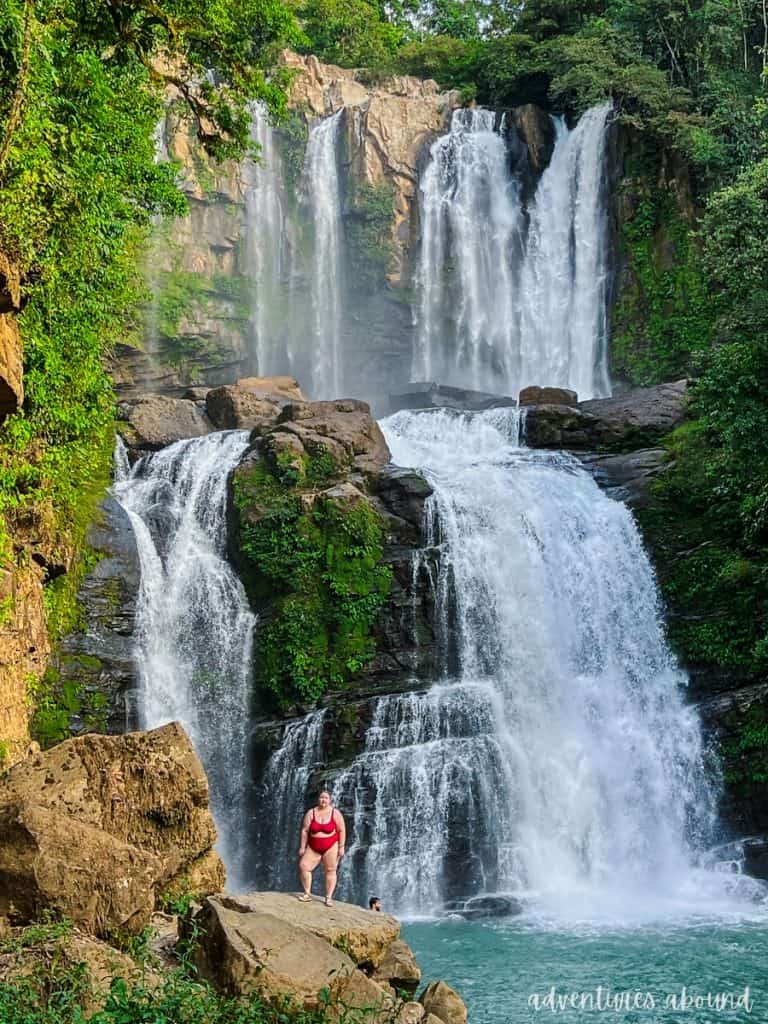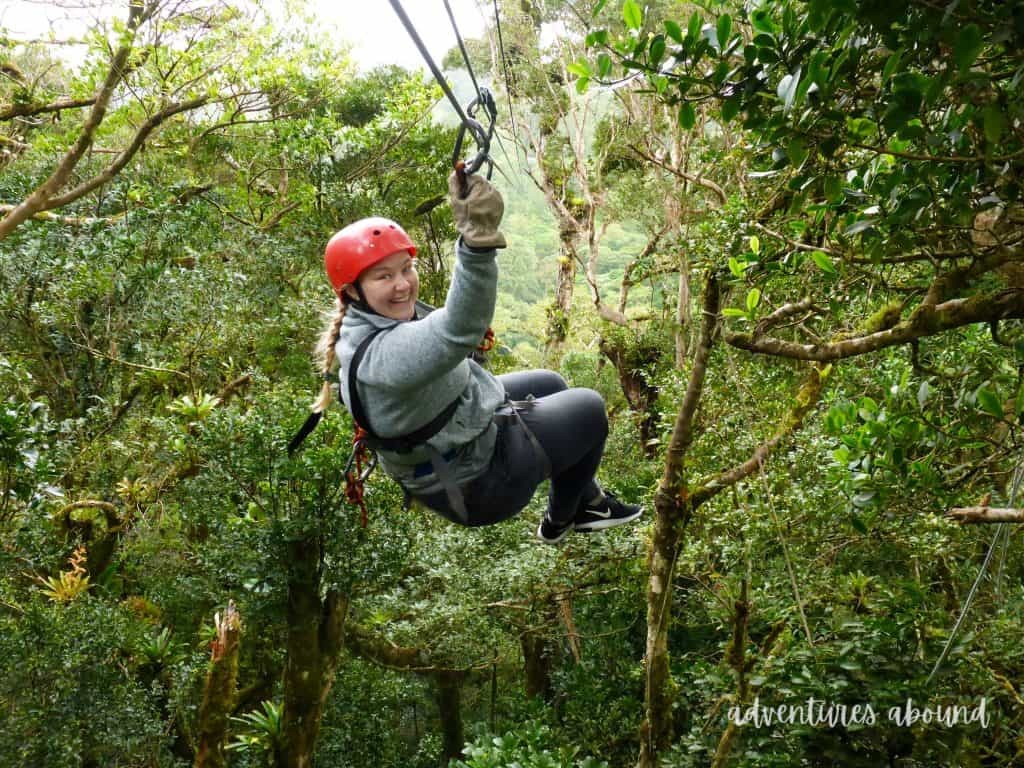Costa Rica, a jewel of Central America, beckons with its incredible biodiversity, stunning beaches, and thrilling adventure activities. Figuring out where to travel to in Costa Rica can be overwhelming, but don’t worry, TRAVELS.EDU.VN is here to help you navigate this paradise. We’ll guide you through the best destinations, ensuring an unforgettable vacation tailored to your desires. Discover the optimal Costa Rica travel destinations, crafting the perfect itinerary, and uncover the natural wonders that await!
1. General Information About Costa Rica For Travelers
Costa Rica, nestled between Nicaragua and Panama in Central America, boasts coastlines on both the Pacific Ocean and the Caribbean Sea. This strategic location contributes to its diverse ecosystems and unique cultural blend. Understanding some basics will enhance your experience in this vibrant nation.
- Location: Central America, bordered by Nicaragua to the north and Panama to the south.
- Coasts: Pacific Ocean (West) and Caribbean Sea (East).
- Language: Spanish is the official language. English is widely spoken in tourist areas, especially by younger generations. A unique English-Creole dialect is prevalent on the Caribbean coast.
- Visa: U.S. tourists can stay for up to 180 days visa-free. Ensure your passport is valid for at least six months beyond your travel dates. Digital nomad visas are available for longer stays.
- Currency: Costa Rican Colón (CRC). The exchange rate fluctuates around 500 CRC to 1 USD. While not the cheapest destination, Costa Rica offers good value compared to similar experiences in the US.
- Weather: Consistently warm year-round. The rainy season spans from May to November, while the dry season lasts from December to April. The Caribbean coast experiences a different pattern, with more rain and mini-dry seasons in March-April and September-October.
 A map of Costa Rica highlighting its location in Central America and its diverse regions
A map of Costa Rica highlighting its location in Central America and its diverse regions
1.1. Costa Rica’s Provinces
Costa Rica is divided into seven provinces, each offering distinct landscapes and attractions. Here’s a quick overview:
| Province | Key Features |
|---|---|
| Guanacaste | Pacific coastline, beaches, surfing, sunshine |
| Puntarenas | Largest province, national parks, diverse wildlife along the Pacific coast |
| Alajuela | Volcanoes, coffee farms, lush landscapes |
| Heredia | Verdant hills, charming villages, often called “Little Switzerland” |
| San José | Bustling capital city, cultural heritage |
| Cartago | Colonial architecture, ancient ruins |
| Limón | Afro-Caribbean influence, vibrant music, unique cuisine, rainforests |
2. What Makes Costa Rica A Traveler’s Dream Destination?
Costa Rica isn’t just another pretty place; it’s an experience that captivates the senses and leaves a lasting impression. Here’s what makes it so special:
2.1. Renowned Coffee Culture
Costa Rica’s coffee is a source of national pride. The country’s high-altitude and volcanic soils create ideal conditions for growing premium Arabica beans. A study by the Coffee Institute of Costa Rica in 2023 showed that Costa Rican coffee beans have a higher density and lower acidity compared to beans from other Central American countries, making them highly sought after globally.
2.2. Nature’s Playground
Despite its small size (approximately 20,000 square miles), Costa Rica boasts an incredible array of natural wonders. From pristine beaches and cascading waterfalls to lush rainforests, misty cloud forests, and towering volcanoes, there’s something to enchant every nature enthusiast.
2.3. Thrilling Adventures Await
Costa Rica is an adventure traveler’s paradise. Ziplining through the rainforest canopy, hiking volcanic trails, white-water rafting down raging rivers, surfing world-class breaks, and rappelling down waterfalls are just a few of the adrenaline-pumping activities on offer.
2.4. Biodiversity Hotspot
Costa Rica is home to an estimated 4% of the world’s biodiversity, despite covering only 0.03% of the Earth’s surface. This incredible concentration of flora and fauna makes it a haven for animal lovers and wildlife enthusiasts.
 A vibrant green rainforest landscape with a cascading waterfall, showcasing Costa Rica's rich biodiversity
A vibrant green rainforest landscape with a cascading waterfall, showcasing Costa Rica's rich biodiversity
3. Navigating Costa Rica: Transportation Options
Getting around Costa Rica doesn’t have to break the bank. A bit of planning and savvy travel tactics can help you explore this beautiful country on a budget.
- Public Buses: Costa Rica’s bus system is extensive, affordable, and reaches even the most remote areas. This is a great way to immerse yourself in local culture and practice your Spanish.
- Small Flights: For those short on time, consider taking small flights to remote destinations like Tortuguero or the Osa Peninsula.
- Boat Transfers: Hiring boats, especially to destinations like Tortuguero or the Nicoya Peninsula, offers a quicker and more convenient alternative to long bus rides.
- Private Shuttles: Private shuttles are available to popular tourist destinations throughout Costa Rica. This is a good option for groups, families, or those with lots of luggage.
3.1. Independent Exploration
If you prefer more flexibility, consider these options:
- Private Drivers: Hiring a private driver allows you to customize your itinerary and benefit from local insights.
- Taxis: Taxis are readily available in major cities. Always confirm the meter is running or agree on a price beforehand.
- Uber: While technically illegal, Uber operates in Costa Rica and can be a cheaper alternative to taxis.
- Car Rentals: Renting a car offers the ultimate freedom to explore at your own pace. However, be aware that insurance is mandatory and can significantly increase the cost.
4. Unforgettable Experiences: Top Things To Do In Costa Rica
From bustling cityscapes to tranquil beaches and lush rainforests, Costa Rica offers a diverse range of activities and attractions.
4.1. San José: More Than Just A Stopover
While many travelers bypass San José, the capital city offers a vibrant cultural scene. Explore museums like the National Museum of Costa Rica, sample international cuisine, and relax in one of the city’s many parks.
4.2. Beach Bliss: Coastal Paradise
Costa Rica is renowned for its stunning beaches, each offering a unique experience. Here are some popular options:
| Region | Beaches |
|---|---|
| Guanacaste | Papagayo, Tamarindo, Playa Conchal, Playas del Coco |
| Nicoya Peninsula | Montezuma, Sámara, Nosara, Manzanillo |
| Pacific Coast | Jacó, Playa Hermosa, Punta Leona, Manuel Antonio, Dominical, Uvita |
| Caribbean Coast | Puerto Viejo (Playa Negra, Playa Cocles, Punta Uva, Playa Chiquita, Playa Manzanillo) |
4.3. Volcanic Majesty: Exploring Costa Rica’s Giants
Costa Rica is home to several impressive volcanoes, each offering unique landscapes and hiking opportunities.
| Volcano | Key Features |
|---|---|
| Irazú | Highest volcano in Costa Rica, lunar-like landscape, panoramic views |
| Poás | One of the largest active craters in the world, accessible viewpoint |
| Arenal | Iconic conical shape, hot springs, adventure activities |
| Rincón de la Vieja | Active volcano, hot springs, waterfalls, diverse ecosystems |
| Tenorio | Home to the vibrant blue Rio Celeste, hiking trails |
4.4. National Park Adventures
Costa Rica’s national parks are treasure troves of biodiversity and natural beauty.
| National Park | Key Features |
|---|---|
| Braulio Carrillo | Lush rainforests, waterfalls, diverse wildlife, hiking |
| Carara | Biological bridge between Amazonian and Mesoamerican ecosystems, birdwatching |
| Cahuita | Coral reefs, white sandy beaches, coastal rainforests, snorkeling, wildlife viewing |
| Tortuguero | Mangrove forests, lagoons, sea turtle nesting |
| Manuel Antonio | Stunning beaches, hiking trails, monkeys, sloths |
| Chirripó | Costa Rica’s highest peak, breathtaking views |
| Palo Verde | Water birds, migratory species |
| Corcovado | “Most biologically intense place on earth,” rare wildlife (jaguars, tapirs) |
 A family hiking through a lush Costa Rican national park, surrounded by vibrant greenery
A family hiking through a lush Costa Rican national park, surrounded by vibrant greenery
4.5. Other Popular Destinations
Beyond the beaches, volcanoes, and national parks, Costa Rica offers a wealth of other exciting destinations:
- Monteverde: Cloud forest, ziplining, incredible biodiversity
- La Fortuna: Arenal volcano, La Fortuna Waterfall, La Paz Gardens, hot springs
- Rio Celeste: Vibrant blue river within Tenorio Volcano National Park
- Osa Peninsula: Corcovado National Park, Drake Bay, Puerto Jimenez, eco-tourism, wildlife
4.6. Day Trips From San José
If you’re based in San José, consider exploring these nearby towns and attractions:
| Destination | Key Features |
|---|---|
| Cartago | Historic city, Basilica of Our Lady of the Angels, ruins of Santiago Apostol Church, Irazu Volcano National Park |
| Alajuela | Birthplace of Juan Santamaria (national hero), Central Park, Zoo Ave (wildlife rescue center) |
| Heredia | “City of Flowers,” colonial architecture, Café Britt (coffee farm) |
| Sarchí | Colorful painted oxcarts, traditional handicrafts, largest hand-painted oxcart in the world |
| Zarcero | Topiary garden, pink and blue church |
| Orosi | Tranquil valley, oldest church in Costa Rica, Tapanti National Park, hot springs |
5. Prioritizing Safety: A Note for Travelers
Costa Rica is generally a safe country for tourists. However, petty theft can occur, particularly in larger cities like San José. Take these precautions:
- Leave valuables locked in your hotel room.
- Be aware of your surroundings, especially in crowded areas.
- Keep bags visible and secure.
- Avoid walking alone at night.
- Never accept drinks from strangers.
According to the U.S. Department of State, the most common crimes reported by tourists in Costa Rica are pickpocketing, bag snatching, and theft from vehicles.
TRAVELS.EDU.VN recommends purchasing travel insurance to protect against unforeseen circumstances, including illness, injury, and theft.
6. Addressing Common Concerns: FAQs About Costa Rica
Planning a trip can be daunting, so we’ve compiled answers to some frequently asked questions:
6.1. What is the best month to go to Costa Rica?
The dry season (December to April) is the most popular time to visit, offering sunny skies and pleasant temperatures. However, avoid traveling during Christmas and Easter week to avoid crowds.
6.2. Is it safe to travel to Costa Rica?
Yes, Costa Rica is generally safe, but petty theft can be common. Take precautions to protect your belongings.
6.3. Is Costa Rica cheap or expensive?
Costa Rica is relatively expensive compared to other Central American countries. Expect prices similar to or slightly lower than those in the US.
6.4. Is tipping a thing in Costa Rica?
Most restaurants include a 10% service charge in the bill, so additional tipping is not necessary.
6.5. Is it illegal to remove shells or sand from Costa Rica?
Yes, it is illegal to remove sand or shells from Costa Rica.
6.6. Can you drink the water in Costa Rica?
Yes, the water is generally safe to drink in Costa Rica, except in the Puerto Viejo area.
 A picturesque beach scene in Costa Rica, with clear turquoise water and lush green vegetation
A picturesque beach scene in Costa Rica, with clear turquoise water and lush green vegetation
7. Conclusion: Your Costa Rican Adventure Awaits
Costa Rica is a truly special destination that offers something for everyone. Whether you’re seeking adventure, relaxation, or cultural immersion, you’ll find it here.
Let TRAVELS.EDU.VN help you plan your dream Costa Rican getaway! We offer customized itineraries, expert advice, and unbeatable deals on flights, hotels, and tours.
Ready to experience the pura vida?
Contact TRAVELS.EDU.VN today at 123 Main St, Napa, CA 94559, United States or Whatsapp: +1 (707) 257-5400, or visit our website at travels.edu.vn to start planning your adventure!
Don’t wait, Costa Rica is calling.
8. More Information
| Sl No. | Question | Answer |
|---|---|---|
| 1 | What are some unique cultural experiences I can have in Costa Rica? | Engage with locals through homestays, attend traditional festivals, learn to cook Costa Rican cuisine, visit indigenous communities to understand their traditions, and explore local markets for authentic crafts. |
| 2 | Can you suggest some off-the-beaten-path destinations in Costa Rica? | Explore the remote Osa Peninsula, visit the Pacuare River for white-water rafting, discover the cloud forests of San Gerardo de Dota, hike to the summit of Cerro Chirripó, and explore the less-visited beaches of the Nicoya Peninsula. |
| 3 | What are some sustainable tourism practices to keep in mind while traveling in Costa Rica? | Choose eco-friendly accommodations, support local businesses, minimize your plastic use, respect wildlife and their habitats, dispose of waste properly, use public transportation or carpool, and educate yourself about local conservation efforts. |
| 4 | What are some essential items to pack for a trip to Costa Rica? | Pack lightweight and quick-drying clothing, rain gear, hiking shoes, insect repellent, sunscreen, a hat, sunglasses, a reusable water bottle, a first-aid kit, a camera, and any necessary medications. |
| 5 | How can I ensure a safe and responsible wildlife encounter in Costa Rica? | Observe animals from a distance, never feed wildlife, avoid disturbing their habitats, choose reputable tour operators who follow ethical guidelines, and report any illegal wildlife activities to the authorities. |
| 6 | What are some popular local dishes I should try in Costa Rica? | Try gallo pinto (rice and beans), casado (traditional plate with rice, beans, meat, and salad), ceviche (marinated seafood), olla de carne (beef stew), and empanadas (savory pastries). Also, sample fresh tropical fruits like mangoes, papayas, and pineapples. |
| 7 | What is the best way to experience Costa Rica’s hot springs? | Visit natural hot springs in areas like La Fortuna, Tabacón, or Ecotermales Fortuna. Choose hot springs that prioritize natural settings and sustainable practices, and avoid overcrowding by visiting during off-peak hours. |
| 8 | Are there any specific health precautions I should take before traveling to Costa Rica? | Consult your doctor about recommended vaccinations and malaria prevention. Drink bottled or purified water, practice good hygiene, avoid mosquito bites, and be cautious about foodborne illnesses. |
| 9 | What are some considerations for traveling to Costa Rica during the rainy season? | Pack rain gear, be prepared for occasional heavy showers, check weather forecasts regularly, choose accommodations with indoor activities, and take advantage of lower prices and fewer crowds. |
| 10 | How can I support local communities and businesses while traveling in Costa Rica? | Stay in locally owned hotels, eat at local restaurants, purchase souvenirs from local artisans, hire local guides and drivers, participate in community-based tourism projects, and donate to local charities or conservation organizations. |
